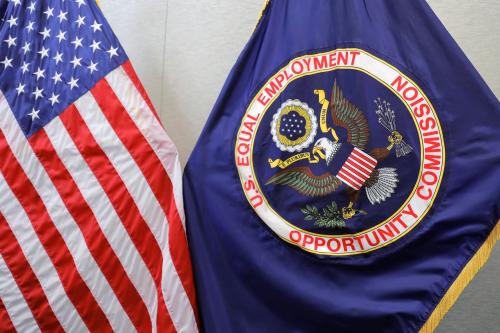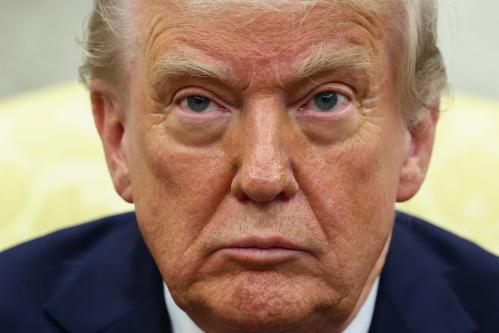Thank you very much Chairman Ravitch and members of the Commission. I am pleased to appear before you this morning and very much appreciate the invitation.
I work for the Brookings Institution’s Metropolitan Policy Program, a nonprofit public policy organization based in Washington, DC. Our mission is to redefine the challenges facing metropolitan America and promote innovative solutions to help communities grow in more inclusive, competitive, and sustainable ways. I work on a range of policy areas with specific emphasis on transportation.
Mr. Chairman, the work of this commission comes at a critical time in our nation’s history. As you know, the issue of transportation funding, and transit funding especially, is very much on the minds of metropolitan area leaders from coast-to-coast. And for good reason.
There are massive changes underway with respect to how Americans travel. After years and years of steady increases, the total amount of driving in the U.S. has slowed down dramatically. In fact, monthly dispatches from the federal highway administration illustrate clearly that as a nation we are driving much less. Cumulative travel for 2008 has decreased by 42.1 billion vehicle miles, the largest drop in driving that this nation has ever seen.1
Without a doubt some of this decrease is attributable to skyrocketing gas prices which, although they have fallen in the last two months, are still one dollar per gallon higher than this time last year.
Partly as a result of the increase in gas prices and the decrease in driving, transit ridership is booming. The American Public Transportation Association recently announced that Americans took more than 2.8 billion trips on public transportation in the second quarter of 2008. This is almost 140 million more trips than last year.2 The New York MTA is responsible for 55 million of these trips.3
Unfortunately, we also know that transit agencies are not immune from the increases in fuel costs and at the same time are struggling to cope with this increased demand. Perversely, 35 percent of transit agencies are considering cuts in service as a result of the increased costs of energy.4 So at the time when the nation needs functioning, reliable, mass transit we are finding many agencies in severe distress.
Mr. Chairman, I mention all this to illustrate the need for innovation and national leadership when it comes to addressing the issue of transit funding.
Sufficient and sustained revenues for metropolitan transit systems, whether generated on a regional or statewide level, are justified given a series of oft-cited benefits that extend far beyond the inherent value of a soundly financed transit system.5
An extensive transit network like the New York MTA, for example, provides important transportation alternatives to those who have options and provides basic mobility for those who do not. It can help mitigate regional air-quality problems by lowering overall automobile emissions and slowing the growth in traffic congestion.6 And it can also provide economic benefits by creating development opportunities around transit stations and help enhance regional economic competitiveness as an important and attractive metropolitan amenity.7
In view of these broader impacts, then, there are a number of potential revenue sources for the MTA:
Gasoline taxes: Transit advocates in many metropolitan areas have promoted regional gasoline taxes as a way to finance transit. For many, gas taxes represent an attractive option because motorists already pay federal, state, and local taxes on motor fuel so the levy would not impose a new type of tax. To be sure, few transit agencies derive their dedicated funding from regional or metropolitan gas taxes (although the taxes are widespread on other jurisdictional levels). But even so such proposals continue to have merit because of their ability to reduce the externalities associated with automobile travel (e.g., congestion, pollution) and induce drivers to use vehicles that are more fuel-efficient.8 However, the long-term feasibility of gasoline taxes as a sustained source of revenues for transportation financing in general is increasingly being called into question.9
Sales taxes: By contrast, regional sales taxes are a very common form of dedicated funding for transit agencies. In the Dallas metropolitan area, for example, a 1-cent sales tax generates about $350 million each year for the transit agency there. In and around Chicago, a complex sales tax in the regional transit authority district generates more than $500 million for the agency. As others have pointed out, the key appeal of a dedicated sales tax for transit is that it has a broad base and significant resources can be raised with a barely noticeable change in the tax rate.10 The main disadvantages of sales taxes are that they are regressive unless modified, and they are not directly related to the use of transportation so they can be unpopular over a wide area. However, the significant amount of revenue this option raises, the relative ease in its administration, and its widespread and successful use to support transit throughout the nation make it a viable alternative.
Parking taxes. A related idea is that of a parking tax to fund transit. A parking tax was first proposed before construction even began on the rail system in Washington, for example.11 Such a source could take the form of a sales tax on commercial parking or an excise tax that all parkers pay. Parking taxes have the added advantage of discouraging vehicle trips and perhaps increasing transit’s share of total trips.12 Parking taxes are currently used in several U.S. cities and in almost every case the primary goal is revenue generation. Parking taxes for transit purposes are enabled by statute in states such as California and Illinois.
Land value capture: Value capture refers to a type of financing where non-transportation users, primarily adjacent property owners who benefit directly from transportation projects, contribute to the costs of such investments. It is often proposed as a way to use public taxing authority to help finance rail transit through taxes on nearby private development, in some ways mimicking the link between private rail transit and private land development a century ago. The idea is that rail systems, by improving accessibility, will increase land values. The increment over any pre-existing property value can then be taxed, thereby “capturing” the benefit that accrues to private landowners by virtue of the public rail investment, and helping to defray rail construction or operating costs. Though the idea of value capture has been discussed in policy circles for years it is employed in relatively few places and most prominently in the form of benefit assessment districts in metropolitan areas including Miami, Los Angeles, and Denver.13
Payroll taxes. Still another potential option is a payroll tax on workers’ earnings in the service area dedicated to covering local operating subsidies. Such a tax could be assessed based on place of employment rather than place of residence in order to expand the tax base to individuals working in the MTA transit district but residing outside of it. The transit district in Portland, OR is supported by such a tax, as are the transit agencies in Cincinnati and Louisville. A payroll tax closely tracks inflation, so revenues would remain quite stable. It can also be made progressive by exempting low-income workers.14
Mr. Chairman, in addition to these options, the one I believe holds the most promise for New York City and the transit agency is a congestion charge. In the words of Sir Rod Eddington—the author of a ground-breaking report on the future of Britain’s transportation infrastructure—congestion pricing is an “economic no-brainer.”15 The real and perceived benefits are the reason there is such a tremendous amount of attention focused on such strategies today.
Congestion and cordon charges. Charging commuters who travel on roads during peak hours is becoming a popular idea throughout the world. Although its applications in the U.S. have been rather limited, receptivity is growing as congestion continues to increase at the same time revenues are become scarcer. Moreover, new toll collection technologies enable charges to be collected without slowing down vehicles, thereby removing a significant barrier to implementing such a plan.
Congestion pricing comes in many forms and involves tolling one of more lanes of a particular roadway to reduce demand to the level of maximum efficient use of road capacity. Under some schemes pricing can vary based on time of day or amount of congestion. Congestion pricing can offer a number of benefits including increased access and revenue for public transit. According to the U.S. DOT, congestion pricing, if adopted in all areas of major congestion, could reduce the need for new roadway capacity by $20 billion.16
Under cordon (or area-wide) congestion pricing a fee is charged for any vehicle that enters the cordoned area, usually a city center. The justification is that vehicles entering the cordoned area impose costs (congestion, air pollution, carbon emissions, road damage, etc.) on the residents of the area that is unfair and cannot be supported by the local tax base. An additional argument is that dense city centers work most efficiently when public road space is allocated in a manner that best sustains overall quality of life. These lessons are evident internationally in cities like Singapore, Stockholm, Oslo, and London which have adopted cordon pricing schemes.17
Most relevant for the discussion of this Commission is that congestion pricing can, and usually does, yield sufficient net revenues to provide for additional bus and rail capacity, bicycle and pedestrian improvements, or projects to provide alternative transportation through other modes within the cordon zone. Yet one important point associated with these international strategies is that revenue generation is not the only objective of cordon-style pricing. The primary objectives and benefits begin almost uniformly with the desire to reduce congestion in the urban core by reducing automobile traffic. Other objectives include increased accessibility, and environmental benefits of reduced vehicle emissions.18
Despite these clear and oft-cited benefits, a critical factor in public acceptance for cordon pricing strategies is how the congestion charge revenues are spent. Complaints about the regressive nature of toll revenues remains a common concern, with low-income and high-income users paying the same price for access to the cordoned area. However, several models show that these and other similar charges could be considered through an expenditure lens, not an income lens. In other words, the equitable distribution of the toll revenue is more important than the equitable distribution of congestion-relief benefits. For example, in Sweden where drivers are charged a fee for entering the city of Stockholm, it is estimated that motorists pay $3 in tolls for every $1 of benefit they receive from congestion relief.19 However there are benefits for those who take advantage of increased transit service, and general benefits to the city such as reduced air pollution.
These tradeoffs between equity, environment and financing needs can be addressed by reinvesting net revenues in creating more travel choices in order to yield the highest net public benefits. In this way, cordon pricing not only reflects the true economic cost of drivers’ use of the roadway network, reduces demand on the system, and promotes equitable treatment of disadvantaged groups; it can generate significant revenue to pay for needed projects.
Mr. Chairman, I applaud you and this commission for your willingness to explore these innovative strategies to fund the MTA’s capital and operating needs. Certainly pitfalls exist and implementation will not be easy. And yet the New York metropolitan area cannot afford to have a transit system that is hampered from operating at its fullest and most efficient potential.
Thank you very much for providing me the opportunity to appear before you today.
The views expressed in this testimony are those of the author alone and do not necessarily represent those of the staff, officers, or trustees of The Brookings Institution.
1U.S. Department of Transportation, “Traffic Volume Trends,” Federal Highway Administration, Office of Highway Policy Information, June 2008.
2American Public Transportation Association, “Public Transportation Ridership Statistics,” various years.
3American Public Transportation Association, “Public Transportation Ridership Statistics,” September 2008.
4American Public Transportation Association, “Impact of Rising Fuel Costs on Transit Services: Survey Results,” May 2008.
5See e.g., Janet Rothenberg Pack, “You Ride, I’ll Pay: Societal Benefits and Transit Subsidies,” Brookings Review 10 (3) (1992) pp. 48–52.
6According to the Texas Transportation Institute, the annual cost of traffic congestion in the New York metropolitan area would increase by $4.2 billion if public transportation service were discontinued. David Schrank and Tim Lomax, “The 2007 Annual Urban Mobility Report,” Texas Transportation Institute, Texas A&M University System: 2007.
7The economic benefits of transit are well documented. A 1997 report found that every dollar invested in transit yields six in economic returns. See e.g., Donald H. Camph, “Dollars and Sense: Economic Case for Public Transportation in America,” Los Angeles: The Campaign for Efficient Passenger Transportation, 1997.
8Robert Puentes and Ryan Prince, “Fueling Transportation Finance: A Primer on the Gas Tax,” in Taking the High Road: A Metropolitan Agenda for Transportation Reform, B. Katz and R. Puentes, eds., Brookings, 2005.
9See e.g., U.S. Department of Transportation, “Highway Trust Fund: Fact Sheet,” September 2008.
10Todd Goldman and Martin Wachs, “A Quiet Revolution in Transportation Finance,” Transportation Quarterly 57 (1) (2003) pp. 19–32.
11This proposal faced strong opposition and was eventually scrapped. Officials also shelved a $1 per day region-wide commuter parking tax in 2002. Such a levy was estimated to have generated $1 billion over three years and would have been applied to commercial garages, as well as parking spaces that employees provide for their workers.
12Donald Shoup, The High Cost of Free Parking, American Planning Association: 2005.
13Jeffrey J. Smith and Thomas A. Gihring, “Financing Transit Systems through Value Capture: An Annotated Bibliography,” American Journal of Economics and Sociology, 65 (3) (2006) pp. 751-786.
14Todd Goldman and others, “Local Option Transportation Taxes in the United States (Part One: Issues and Trends)” Institute of Transportation Studies, University of California at Berkeley, UCB-ITS-RR-2001-3, 2001.
15Rod Eddington, Speech to the Commonwealth Club, London, December 1, 2006.
16Peter R. Orszag, “Current and Future Investment in Infrastructure,” Testimony before the Committee on the Budget and the Committee on Transportation and Infrastructure, U.S. House of Representatives, May 8, 2008.
17See: Anthony Downs, Still Stuck in Traffic: Coping with Peak Hour Congestion, Brookings Press, 2004.
18See e.g, Gunnar Söderholm, “The Stockholm Trial: Congestion Charging and Improved Public Transport Aimed at Reducing Traffic Jams and Creating a Better Environment,” presentation at State Summit on Innovative Transportation Funding and Financing, Washington, D.C., June 24-25, 2008; Milan Agency for Mobility and Environment, “Study for the Application of Road Pricing in Milan,” undated.
19David King and others, “The Political Calculus of Congestion Pricing,” Transport Policy 14 (2007) 111–123.
The Brookings Institution is committed to quality, independence, and impact.
We are supported by a diverse array of funders. In line with our values and policies, each Brookings publication represents the sole views of its author(s).



Commentary
TestimonyOptions for Metropolitan Transit Funding
September 15, 2008